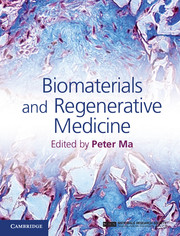Book contents
- Frontmatter
- Contents
- List of contributors
- Preface
- Part I Introduction to stem cells and regenerative medicine
- Part II Porous scaffolds for regenerative medicine
- Part III Hydrogel scaffolds for regenerative medicine
- Part IV Biological factor delivery
- 20 Growth factor delivery on scaffolds
- 21 Gene delivery for periodontal regeneration
- 22 Endogenous stem/progenitor cell recruitment for tissue regeneration
- 23 Affinity-based delivery systems
- 24 DNA delivery for regeneration
- Part V Animal models and clinical applications
- Index
- References
21 - Gene delivery for periodontal regeneration
from Part IV - Biological factor delivery
Published online by Cambridge University Press: 05 February 2015
- Frontmatter
- Contents
- List of contributors
- Preface
- Part I Introduction to stem cells and regenerative medicine
- Part II Porous scaffolds for regenerative medicine
- Part III Hydrogel scaffolds for regenerative medicine
- Part IV Biological factor delivery
- 20 Growth factor delivery on scaffolds
- 21 Gene delivery for periodontal regeneration
- 22 Endogenous stem/progenitor cell recruitment for tissue regeneration
- 23 Affinity-based delivery systems
- 24 DNA delivery for regeneration
- Part V Animal models and clinical applications
- Index
- References
Summary
Gene therapy for regenerative medicine
Gene therapy refers to the delivery of genetic material that will activate, hinder, or modify the expression of specific genes to facilitate the natural cellular production of a therapeutic agent to treat disease [1, 2]. The concept has emerged as an effective method to control the course of a disease/disorder, modulate the host-response triggered by pathogen, or regenerate compromised biological tissues [2]. As such, the use of gene delivery technologies offers a novel approach for delivery of putative regenerative molecules to sites in the oral cavity and craniofacial complex [2]. Gene therapy is more advantageous than the traditional therapeutic delivery of compounds and proteins. A greater sustainability in comparison with a single dosage or several of a protein or compound is one of the primary advantages of therapeutic gene delivery. Although the half-lives of conventional pharmaceutical compounds or recombinant proteins range from hours to a few days, viral vector-gene delivery of the corresponding genes can lead to in-vivo expression lasting from weeks to years. Gene therapy also alleviates technical challenges that arise with protein expression and purification. Furthermore, gene delivery of an entire group of regenerative factors combined with existing tissue regeneration therapies could potentially replicate natural biological healing processes and allow engineering of complex three-dimensional (3D), multitissue structures (Figure 21.1) [2]. Therapeutic gene delivery for tissue regeneration is achieved through the use of both viral and non-viral vectors (Table 21.1).
- Type
- Chapter
- Information
- Biomaterials and Regenerative Medicine , pp. 391 - 404Publisher: Cambridge University PressPrint publication year: 2014



